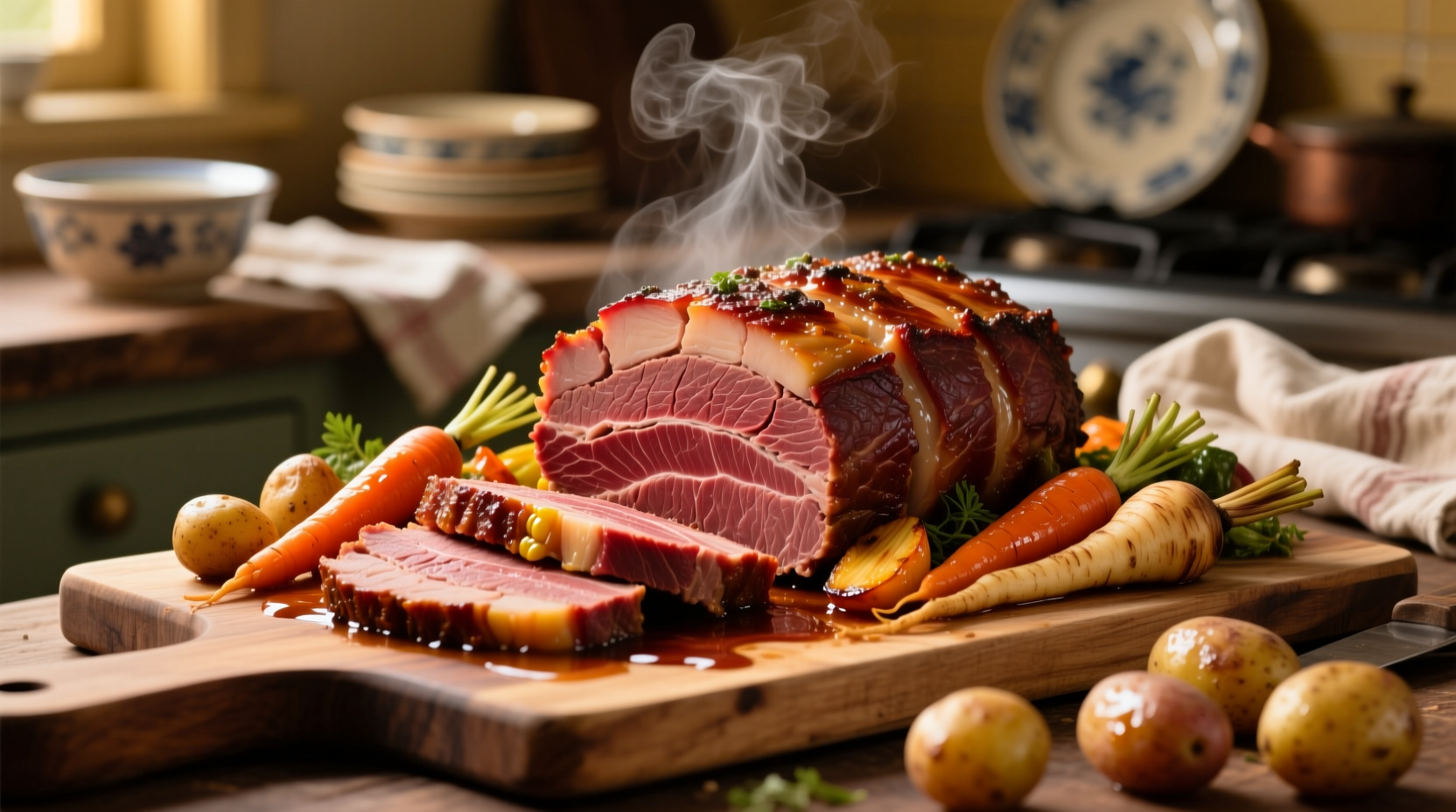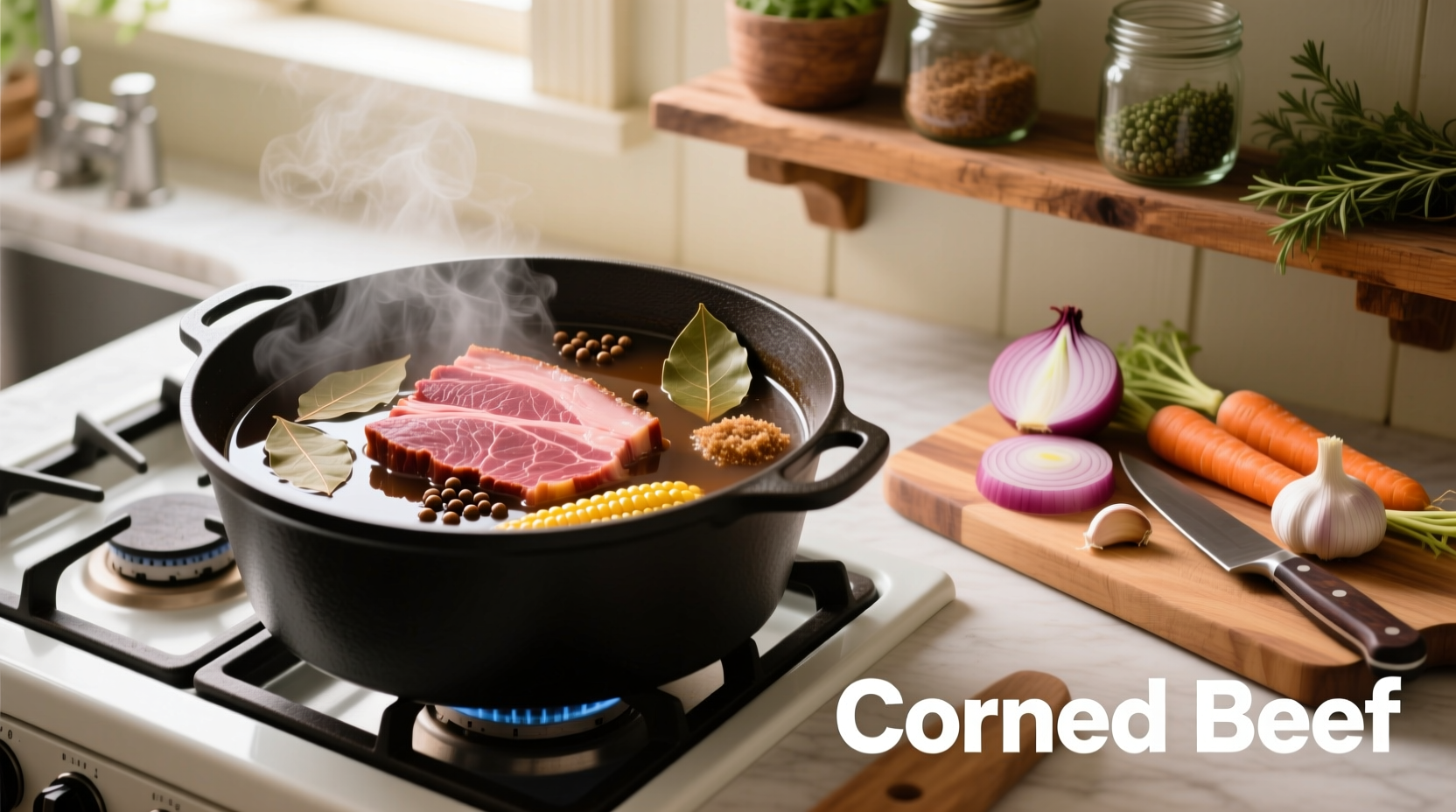For perfectly tender corned beef, simmer a 3-4 pound brisket for 2.5-3 hours after rinsing excess salt. Use a meat thermometer to ensure internal temperature reaches 160°F (71°C) for food safety while maintaining tenderness. The key is low, gentle heat with aromatics like onions, garlic, and bay leaves.
Nothing beats the rich aroma of corned beef simmering on the stove, filling your kitchen with savory spices. As someone who's explored European culinary traditions for over 15 years, I've discovered that perfect corned beef isn't about complicated techniques—it's understanding the simple principles that transform this humble cut into something extraordinary.
Understanding Corned Beef Basics
Corned beef starts as beef brisket cured in a seasoned brine, typically containing salt, sugar, and curing salt (sodium nitrite) along with spices like peppercorns, mustard seeds, and bay leaves. The "corn" refers to the large salt crystals historically used in the curing process.
When selecting corned beef, you'll typically find two cuts:
| Cut Type | Texture Characteristics | Best Cooking Method |
|---|---|---|
| Flat Cut | Leaner, more uniform shape | Boiling or braising |
| Point Cut | More marbling, richer flavor | Slow cooking for maximum tenderness |
The USDA Food Safety and Inspection Service recommends cooking beef to a minimum internal temperature of 145°F (63°C) with a three-minute rest time, but for tougher cuts like brisket, higher temperatures between 160-205°F (71-96°C) break down collagen for optimal tenderness without drying out the meat. Source: USDA Food Safety Guidelines
Essential Preparation Steps
Before cooking, proper preparation ensures balanced flavor:
- Rinse thoroughly under cold water to remove excess surface salt
- Soak for 30 minutes in fresh water if extremely salty (taste a small piece to determine)
- Gather aromatics: onion, garlic cloves, bay leaves, and the spice packet often included with store-bought corned beef
Professional chefs at the Culinary Institute of America emphasize that proper rinsing prevents overly salty results while preserving the cured flavor. Skipping this step is the most common mistake home cooks make with store-bought corned beef.

Step-by-Step Cooking Methods
Traditional Stovetop Method (Recommended)
- Place corned beef in a large pot, fat side up
- Add enough cold water to cover by 1 inch (2.5 cm)
- Bring to a gentle simmer (not a rolling boil) over medium heat
- Add aromatics and any included spice packet
- Cover and reduce heat to maintain a gentle simmer
- Cook for 2.5-3 hours for a 3-4 pound brisket (45-60 minutes per pound)
- Check tenderness with a fork—it should slide in easily
Slow Cooker Alternative
For hands-off cooking, place rinsed corned beef in slow cooker with aromatics and 2 cups of liquid (water, beer, or broth). Cook on low for 8-10 hours or high for 4-5 hours. The slow cooker's gentle heat produces exceptionally tender results but requires longer cooking time.
Troubleshooting Common Issues
Too Salty?
If your corned beef tastes overly salty:
- Continue simmering with fresh water (change water once)
- Add a peeled potato to the pot—it absorbs excess salt
- Finish cooking with unsalted broth instead of water
Too Tough?
Brisket contains substantial connective tissue that needs proper time to break down:
- Extend cooking time by 30-60 minutes
- Ensure liquid maintains a gentle simmer, not a boil
- Check with a meat thermometer—160°F (71°C) is the minimum safe temperature, but 190-205°F (88-96°C) yields maximum tenderness
According to food science research from America's Test Kitchen, the collagen in brisket begins transforming to gelatin at 160°F (71°C) but reaches optimal tenderness between 190-205°F (88-96°C), explaining why many traditional recipes recommend longer cooking times.
Serving and Storage Tips
For perfect slicing:
- Rest cooked corned beef for 15-20 minutes
- Identify the grain direction (muscle fibers)
- Cut against the grain in 1/4-inch slices for maximum tenderness
Traditional Irish-American pairings include:
- Steamed cabbage with caraway seeds
- Buttery boiled potatoes
- Mustard sauce (1/4 cup mustard + 2 tbsp vinegar + 1 tbsp sugar)
Store leftovers in an airtight container with cooking liquid for up to 4 days. The flavorful broth makes excellent base for split pea soup or corned beef hash.











 浙公网安备
33010002000092号
浙公网安备
33010002000092号 浙B2-20120091-4
浙B2-20120091-4